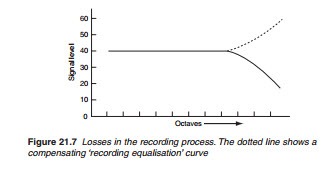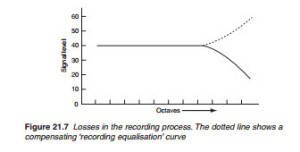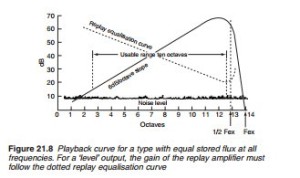Replay considerations
As with any magnetic transfer system, the output from the replay head is proportional to the ‘rate of change’ of magnetic flux. Thus, assuming a constant flux density on the recorded tape, the replay head output will
double for each doubling of frequency. With a doubling of frequency known as an octave and a doubling of voltage being 6 dB, the relationship 6 dB/octave holds good until the extinction frequency, fex, is approached, when the head output rapidly falls towards zero. This is shown in Figure
The upper limit of the curve is governed by the level of the signal recorded on the tape, limited in turn by the tape’s magnetic saturation point. At the low-frequency end, the replay head output is low due to the low rate of change of the off-tape flux. At some point, it will be lost in the ‘noise’ off-tape, and this will occur at about 60 dB down from peak level. Thus, even with playback equalisation (represented by the dotted curve in Figure 21.8), the dynamic range of the system is confined to 60 dB or so. With the unalterable 6 dB/octave characteristic, we are limited, then, to a total recording range of 10 octaves. This is inherent in the tape system and applies equally to audio and video signals. Ten octaves will afford an audio response from 20 Hz to 20 kHz, which is quite adequate. TV pictures, however, even substandard ones for domestic entertainment, demand an octave range approaching 18 and this is plainly not possible.


